San Carlos, Pangasinan
This article needs additional citations for verification. (September 2013) |
San Carlos | |
|---|---|
| City of San Carlos | |
 Downtown area | |
| Nickname(s): Heart of Pangasinan Linguistical center of the Pangasinan language | |
 Map of Pangasinan with San Carlos highlighted | |
Location within the Philippines | |
| Coordinates: 15°55′41″N 120°20′56″E / 15.92806°N 120.34889°E | |
| Country | |
| Region | Ilocos Region |
| Province | Pangasinan |
| District | 3rd district |
| Founded | 1578 |
| Cityhood | January 1, 1966 |
| Named for | Charles III of Spain |
| Barangays | 86 (see Barangays) |
| Government | |
| • Type | Sangguniang Panlungsod |
| • Mayor | Julier C. Resuello |
| • Vice Mayor | Joseres S. Resuello |
| • Representative | Maria Rachel J. Arenas |
| • City Council | Members |
| • Electorate | 126,283 voters (2022) |
| Area | |
| • Total | 169.03 km2 (65.26 sq mi) |
| Elevation | 12 m (39 ft) |
| Highest elevation | 172 m (564 ft) |
| Lowest elevation | 0 m (0 ft) |
| Population (2020 census)[3] | |
| • Total | 205,424 |
| • Density | 1,200/km2 (3,100/sq mi) |
| • Households | 47,785 |
| Economy | |
| • Income class | 3rd city income class |
| • Poverty incidence | 17.90 |
| • Revenue | ₱ 941.4 million (2020) |
| • Assets | ₱ 2,525 million (2020) |
| • Expenditure | ₱ 699.5 million (2020) |
| • Liabilities | ₱ 655.7 million (2020) |
| Service provider | |
| • Electricity | Central Pangasinan Electric Cooperative (CENPELCO) |
| Time zone | UTC+8 (PST) |
| ZIP code | 2420 |
| PSGC | |
| IDD : area code | +63 (0)75 |
| Native languages | Pangasinan Ilocano Tagalog |
| Website | sancarloscitypangasinan |
San Carlos City, officially the City of San Carlos (Pangasinan: Siyudad na San Carlos; Ilocano: Siudad ti San Carlos; Filipino: Lungsod ng San Carlos), is a 3rd class component city in the province of Pangasinan, Philippines. According to the 2020 census, it has a population of 205,424 people.[3] It is the most populated city in Pangasinan and the entire Ilocos Region.
San Carlos City is 19 kilometers (12 mi) from Lingayen and 208 kilometers (129 mi) from Manila.
Etymology
[edit]San Carlos, formerly known as Binalatongan, experienced significant historical events that influenced its name change. In 1660, a revolt led by Andres Malong, and later another insurrection in 1762 headed by Juan dela Cruz Palaris, culminated in humiliating defeats for the Spanish colonial forces. These uprisings prompted King Carlos III of Spain to order the destruction of Binalatongan. Following this directive, the town was razed and subsequently renamed San Carlos, which remains its name today. The renaming served both as a punitive measure and as a means to establish a new order in the aftermath of the rebellions.[5]
History
[edit]Spanish colonial era
[edit]Origins
[edit]San Carlos, originally known as Binalatongan, was inhabited by the San Carlenians, who were of Malayan race. They spoke Cabuloan, the original Pangasinan dialect. The San Carlenians were known for their staunch adherence to their beliefs and practices, leading to frequent conflicts with the Augustinian friars. These clashes ultimately forced the Augustinians to abandon the area. However, the Dominicans later succeeded where the Augustinians had failed, establishing San Carlos as a Christian community.
The town's history is marked by significant uprisings led by prominent local figures. Andres Malong and Juan dela Cruz Palaris are two of the most notable leaders. Palaris, whose real name was Pantaleon Perez, earned his moniker due to his agility and skill in native fencing, known as "eskrima de mano." He spearheaded a revolt against the Spanish authorities in 1762, which lasted for two years and spread across Pangasinan. His resistance against excessive tribute and forced labor led to the establishment of an independent government based in Binalatongan.
Revolts
[edit]The first significant revolt in the area occurred in 1660, led by Andres Malong. In 1718, during a minor uprising led by Juan Caragay, the church and its convent were set on fire, prompting the relocation of the Poblacion east of the San Juan River. This transfer occurred on November 4, 1718, coinciding with the feast of Saint Charles Borromeo, leading to the settlement being renamed San Carlos Binalatongan.[6]
Royal degree and final renaming
[edit]In 1763, during another revolt led by Juan dela Cruz Palaris, the convent and the church of Saint Dominic were once again set ablaze. This event led King Charles III of Spain to issue a decree relocating the site to a place then known as "Lucban." The town's major involvement in these uprisings resulted in a royal mandate to rename the town after the Spanish monarch, thus it was renamed San Carlos.
From its foundation until 1764, the Poblacion and the church were relocated several times within the town's present boundaries. The initial site was on the western bank of the Agno River near the Zambales Mountains, likely within the town of Aguilar. It was later moved to the eastern side of the river, within the present barangay Mabalbalino, where it remained through the second half of the 17th century.
The town's rich history of resistance and resilience is encapsulated in its evolution from Binalatongan to San Carlos, reflecting the enduring spirit of its inhabitants and their significant role in regional history.[7]
Philippine independence
[edit]During the 1960s, the Municipality of San Carlos divided into two precincts. In 1965, the smaller precinct became legally incorporated as the Municipality of Basista by virtue of Republic Act No. 4866.[8]
Cityhood
[edit]In 1966, the larger precinct became legally incorporated as San Carlos City by virtue of Republic Act No. 4487.[9]
Contemporary
[edit]On April 28, 2007, San Carlos City's former mayor Julian V. Resuello was assassinated during an event at the city's plaza. His own family was accused in this assassination. He later died after two days.[10]
Geography
[edit]Barangays
[edit]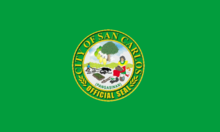
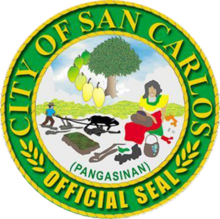
San Carlos is politically subdivided into 87 barangays. Each barangay consists of puroks and some have sitios.
- Abanon
- M.Soriano St. (Poblacion)
- Agdao
- Anando
- Antipangol
- Aponit
- Bacnar
- Balaya
- Balayong
- Baldog
- Balite Sur
- Balococ
- Bani
- Bega
- Bocboc
- Bugallon-Posadas Street (Poblacion)
- Bogaoan
- Bolingit
- Bolosan
- Bonifacio (Poblacion)
- Buenglat
- Burgos-Padlan (Poblacion)
- Cacaritan
- Caingal
- Calobaoan
- Calomboyan
- Capataan
- Caoayan-Kiling
- Cobol
- Coliling
- Cruz
- Doyong
- Gamata
- Guelew
- Ilang
- Inerangan
- Isla
- Libas
- Lilimasan
- Longos
- Lucban (Poblacion)
- Mabalbalino
- Mabini (Poblacion)
- Magtaking
- Malacañang
- Maliwara
- Mamarlao
- Manzon
- Matagdem
- Mestizo Norte
- Naguilayan
- Nelintap
- Padilla-Gomez (Poblacion)
- Pagal
- Palaming
- Palaris (Poblacion)
- Palospos
- Pangalangan
- Pangoloan
- Pangpang
- Paitan-Panoypoy
- Parayao
- Payapa
- Payar
- Perez Boulevard (Poblacion)
- PNR Site (Poblacion)
- Polo
- Quezon Boulevard (Poblacion)
- Quintong
- Rizal Avenue (Poblacion)
- Roxas Boulevard (Poblacion)
- Salinap
- San Juan
- San Pedro (Poblacion)
- Sapinit
- Supo
- Talang
- Taloy (Poblacion)
- Tamayo
- Tandoc
- Tarece
- Tarectec
- Tayambani
- Tebag
- Turac
- Ano
- Tandang Sora (Poblacion)
Climate
[edit]| Climate data for San Carlos | |||||||||||||
|---|---|---|---|---|---|---|---|---|---|---|---|---|---|
| Month | Jan | Feb | Mar | Apr | May | Jun | Jul | Aug | Sep | Oct | Nov | Dec | Year |
| Mean daily maximum °C (°F) | 31 (88) |
31 (88) |
31 (88) |
33 (91) |
32 (90) |
32 (90) |
30 (86) |
30 (86) |
30 (86) |
31 (88) |
31 (88) |
31 (88) |
31 (88) |
| Mean daily minimum °C (°F) | 21 (70) |
21 (70) |
22 (72) |
24 (75) |
24 (75) |
24 (75) |
23 (73) |
23 (73) |
23 (73) |
23 (73) |
23 (73) |
22 (72) |
23 (73) |
| Average precipitation mm (inches) | 5.1 (0.20) |
11.6 (0.46) |
21.1 (0.83) |
27.7 (1.09) |
232.9 (9.17) |
350.8 (13.81) |
679.8 (26.76) |
733.1 (28.86) |
505 (19.9) |
176.6 (6.95) |
67.2 (2.65) |
17.7 (0.70) |
2,828.6 (111.38) |
| Average rainy days | 3 | 3 | 3 | 4 | 14 | 18 | 23 | 25 | 22 | 15 | 8 | 4 | 142 |
| Source: World Weather Online[11] | |||||||||||||
Demographics
[edit]
| Year | Pop. | ±% p.a. |
|---|---|---|
| 1903 | 27,166 | — |
| 1918 | 35,780 | +1.85% |
| 1939 | 47,334 | +1.34% |
| 1948 | 61,671 | +2.98% |
| 1960 | 73,900 | +1.52% |
| 1970 | 84,333 | +1.33% |
| 1975 | 90,882 | +1.51% |
| 1980 | 101,243 | +2.18% |
| 1990 | 124,529 | +2.09% |
| 1995 | 134,039 | +1.39% |
| 2000 | 154,264 | +3.06% |
| 2007 | 161,884 | +0.67% |
| 2010 | 175,103 | +2.90% |
| 2015 | 188,571 | +1.42% |
| 2020 | 205,424 | +1.70% |
| Source: Philippine Statistics Authority[12][13][14][15] | ||
Economy
[edit]Poverty incidence of San Carlos
5
10
15
20
25
30
2006
29.50 2009
26.43 2012
15.98 2015
12.27 2018
12.73 2021
17.90 Source: Philippine Statistics Authority[16][17][18][19][20][21][22][23] |

The city is also called the "Mango-Bamboo Capital of the Philippines", San Carlos has the largest number of mango trees – their fruits are among the most flavorsome in the country – and a thriving bamboocraft industry. An agroindustrial city, San Carlos also engages in livestock raising, crop production, inland fishing, pottery, food processing, tourism, commerce and trade, small-scale manufacturing, and flour-making. San Carlos is said to have an ideal investment potential because of its large land area, big population and strategic location, being in the center of Pangasinan.
Government
[edit]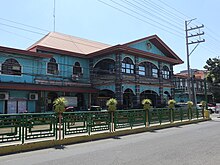
Local government
[edit]San Carlos, belonging to the third congressional district of the province of Pangasinan, is governed by a mayor designated as its local chief executive and by a municipal council as its legislative body in accordance with the Local Government Code. The mayor, vice mayor, and the councilors are elected directly by the people through an election which is being held every three years.
Elected officials
[edit]| Position | Name |
|---|---|
| District Representative (3rd Legislative District the Province of Pangasinan) |
Rose Marie J. Arenas |
| Chief Executive of the City of San Carlos | Mayor Julier C. Resuello |
| Presiding Officer of the City Council of San Carlos | Vice Mayor Joseres S. Resuello |
| Councilors of the City of San Carlos | Sam Baniqued |
| Jack Lester P. Soriano | |
| Eduardo R. Garcia | |
| Joshua G. Resuello | |
| Christian Carlo A. Cancino | |
| Winston Millora | |
| Alberto S. Castro | |
| Carmina D. Paningbatan | |
| Jun Banaag | |
| Karen Joyce Frias |
Tourism
[edit]
Interesting spots of the town include:
- 435-year-old Minor Basilica of Saint Dominic
- Speaker Eugenio Perez Memorial Park
- City Plaza
- Quadricentennial Arch in Bolingit
- Binalatongan Ruins in San Juan
- Philippine Fruit Corporation at Barangay Pagal
Giant mango pie
[edit]On April 26, 2011, 86 barangays in San Carlos baked a 100-square-meter mango pie — filling a gymnasium and setting the largest mango pie world record (400 sqm na mango pie, iniluto sa San Carlos City). Natives used 400 trays of mango pies (10 kilos each, P 400,000, in a 100-square-meter table and shared by more than 1,200). It highlighted San Carlos City's Mango-Bamboo Festival 2011.[25][26][27][28]
Transportation
[edit]Bus companies with service to and from Manila include Five Star Bus Company, Dagupan Bus Company, Fermina Express, Pangasinan Solid North Transit, Inc., First North Luzon Transit, .
Jeepneys are available for commuters to its neighboring towns, like Calasiao and Malasiqui. Tricycles are available for commuters to barrios and barangays.
Gallery
[edit]-
View of the city from the Bell Tower
-
Eugenio Pérez Memorial Building, Museum
-
Kaluyagan Rural Bank and Palaris Colleges School (JT Baun Building)
-
Pangasinan Provincial Hospital
References
[edit]- ^ City of San Carlos | (DILG)
- ^ "2015 Census of Population, Report No. 3 – Population, Land Area, and Population Density" (PDF). Philippine Statistics Authority. Quezon City, Philippines. August 2016. ISSN 0117-1453. Archived (PDF) from the original on May 25, 2021. Retrieved July 16, 2021.
- ^ a b Census of Population (2020). "Region I (Ilocos Region)". Total Population by Province, City, Municipality and Barangay. Philippine Statistics Authority. Retrieved July 8, 2021.
- ^ "PSA Releases the 2021 City and Municipal Level Poverty Estimates". Philippine Statistics Authority. April 2, 2024. Retrieved April 28, 2024.
- ^ "San Carlos City". Province of Pangasinan Official Website. Retrieved June 4, 2024.
- ^ "The Beautiful Place that is San Carlos, Pangasinan". triptheislands.com. August 9, 2015. Retrieved November 4, 2022.
- ^ "History". sancarlospangasinan.gov.ph. Retrieved June 4, 2024.
- ^ "Republic Act No. 4866 – An Act Declaring Basista, Province of Pangasinan, Created by Executive Order Numbered Four Hundred Forty-Six Dated September Five, Nineteen Hundred Sixty-One, as a Duly Constituted Municipality". laws.chanrobles.com. Chan Robles Virtual Law Library. May 8, 1967. Retrieved November 21, 2019.
- ^ "Republic Act No. 4487 – An Act Creating the City of San Carlos in Pangasinan". laws.chanrobles.com. Chan Robles Virtual Law Library. June 19, 1965. Retrieved November 21, 2019.
- ^ Myds Supnad (May 2, 2007). "Cops identify gunman in killing of San Carlos mayor". The Philippine Star. Philstar Global Corp. Retrieved November 21, 2019.
- ^ "San Carlos, Pangasinan: Average Temperatures and Rainfall". World Weather Online. Retrieved October 31, 2015.
- ^ Census of Population (2015). "Region I (Ilocos Region)". Total Population by Province, City, Municipality and Barangay. Philippine Statistics Authority. Retrieved June 20, 2016.
- ^ Census of Population and Housing (2010). "Region I (Ilocos Region)" (PDF). Total Population by Province, City, Municipality and Barangay. National Statistics Office. Retrieved June 29, 2016.
- ^ Censuses of Population (1903–2007). "Region I (Ilocos Region)". Table 1. Population Enumerated in Various Censuses by Province/Highly Urbanized City: 1903 to 2007. National Statistics Office.
- ^ "Province of Pangasinan". Municipality Population Data. Local Water Utilities Administration Research Division. Retrieved December 17, 2016.
- ^ "Poverty incidence (PI):". Philippine Statistics Authority. Retrieved December 28, 2020.
- ^ "Estimation of Local Poverty in the Philippines" (PDF). Philippine Statistics Authority. November 29, 2005.
- ^ "2003 City and Municipal Level Poverty Estimates" (PDF). Philippine Statistics Authority. March 23, 2009.
- ^ "City and Municipal Level Poverty Estimates; 2006 and 2009" (PDF). Philippine Statistics Authority. August 3, 2012.
- ^ "2012 Municipal and City Level Poverty Estimates" (PDF). Philippine Statistics Authority. May 31, 2016.
- ^ "Municipal and City Level Small Area Poverty Estimates; 2009, 2012 and 2015". Philippine Statistics Authority. July 10, 2019.
- ^ "PSA Releases the 2018 Municipal and City Level Poverty Estimates". Philippine Statistics Authority. December 15, 2021. Retrieved January 22, 2022.
- ^ "PSA Releases the 2021 City and Municipal Level Poverty Estimates". Philippine Statistics Authority. April 2, 2024. Retrieved April 28, 2024.
- ^ "2019 National and Local Elections" (PDF). Commission on Elections. Retrieved March 7, 2022.
- ^ Manila Bulletin
- ^ "Giant mango pie aims for Guinness world record". ABS-CBN News.
- ^ BP: 400 sqm na mango pie, iniluto sa San Carlos City | Balita Pilipinas | GMA News Online
- ^ Largest Mango Pie: Philippines sets world record
- ^ Austria, Hilda (August 22, 2024). "Fire razes old public market in Pangasinan city". Philippine News Agency. Retrieved August 23, 2024.





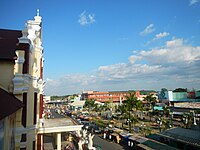
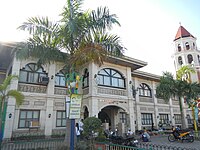

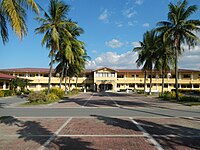
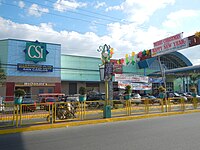
![Old public market in 2015 (razed by 2024 fire[29]](http://upload.wikimedia.org/wikipedia/commons/thumb/8/8a/05146jfBonifacio_Burgos_Soriano_Poblacion_Palaris_Perez_Boulevard_San_Carlos_Pangasinanfvf_15.JPG/200px-05146jfBonifacio_Burgos_Soriano_Poblacion_Palaris_Perez_Boulevard_San_Carlos_Pangasinanfvf_15.JPG)
